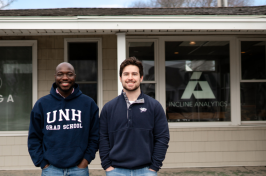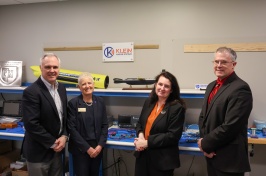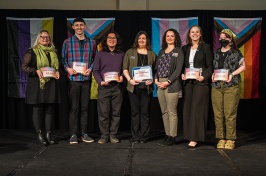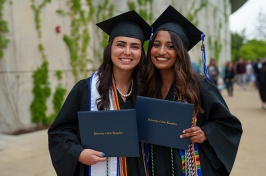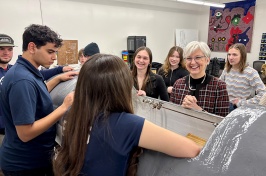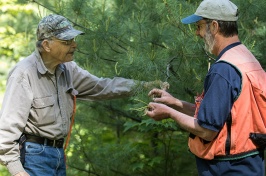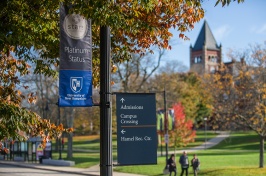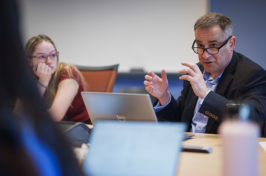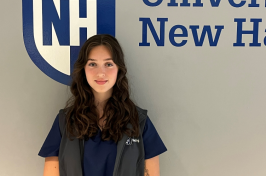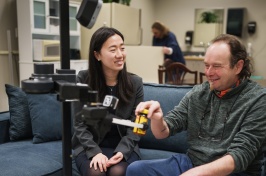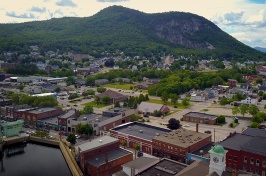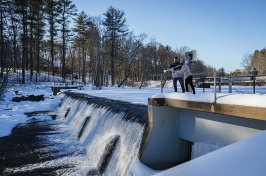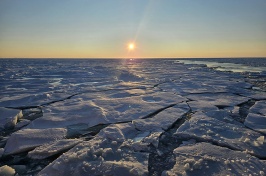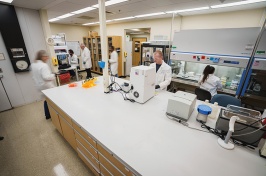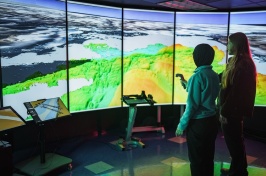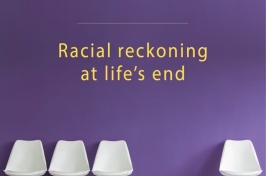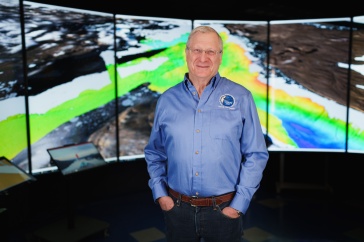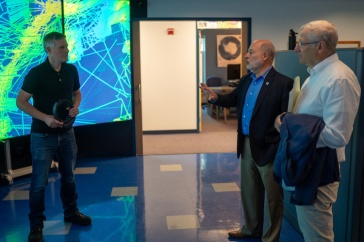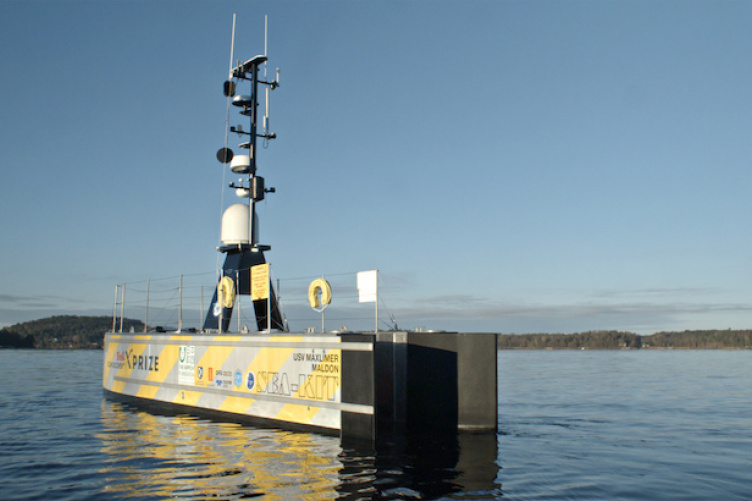
The GEBCO-Nippon Foundation Alumni Team designed this uncrewed surface vessel (USV), SEA-KIT MAXLIMER, that pairs with an autonomous underwater vehicle to map the seafloor remotely.
A team of UNH alumni has won the Shell Ocean Discovery XPRIZE, a global competition to advance deep-sea technologies for ocean floor exploration. The GEBCO-Nippon Foundation Alumni Team — alumni and industry partners and advisors based at UNH’s Center for Coastal and Ocean Mapping (CCOM) — prevailed against teams from around the world to win the top prize of $4 million for their concept.
The award was presented at a ceremony at the Musée Océanographique de Monaco in Monaco Friday, May 31, 2019.
“This Shell Ocean Discovery challenge asked us to develop better ways of mapping the seafloor. We and other teams have succeeded,” said team leader Rochelle Wigley, director of UNH’s Nippon Foundation/GEBCO (General Bathymetric Chart of the Oceans) ocean bathymetry training program, in her acceptance speech. “With all of you, we will now contribute towards mapping our oceans.”
The GEBCO-NF Alumni Team includes 16 alumni of UNH’s Nippon Foundation/GEBCO program: Evgenia Bazhenova (Russia), Aileen Bohan (Ireland), Mohamed Elsaied (Egypt), Andres Fitzcarrald (Peru), UNH data analyst Tomer Ketter (Israel), Christina Lacerda (Brazil), UNH graduate student Jaya Roperez (Philippines), Azmi Rosedee (Malaysia), Ivan Ryzhov (Russia), Hadar Sade (Israel), Sattiabaruth Seeboruth (Mauritius), Masano Sumiyoshi (Japan), Neil Tinmouth (South Africa), Rochelle Anne Wigley (U.S.), Yulia Zarayskaya (Russia) and Karolina Zwolak (Poland). Most team members attended the award ceremony, as did CCOM director Larry Mayer and many of the team’s industry advisors.
“Getting to this point has been a truly international effort. Our diverse nationalities, backgrounds, and specialities have been our greatest asset, and are the reason we made it this far,” Wigley added. “We are the result of The Nippon Foundation’s investment in training a new generation of ocean mappers at the University of New Hampshire for the last fifteen years.”
The team’s winning concept utilized the SEA-KIT uncrewed surface vessel (USV) Maxlimer, alongside the Kongsberg Maritime HUGIN autonomous underwater vehicle (AUV) system. Pairing the HUGIN AUV, rated to operate at depths of up to 4,500 metres, with the SEA-KIT USV (designed by the team), which has the ability to autonomously launch and recover the AUV and acts as a communication link during subsea survey operations, made for efficient, safe and cost-effective seafloor mapping.

The system delivers significant potential benefits over traditional mapping missions using multibeam echosounder technology, which typically require large research ships with full scientific crews on board, resulting in costs of tens of thousands of dollars per day. The USV/AUV model has demonstrated that high-quality bathymetric data can be obtained inexpensively with little to no human involvement at sea. This approach supports the goals of The Nippon Foundation-GEBCO Seabed 2030 project to map the entire seafloor by 2030; currently less than ten percent of the world’s oceans have been mapped to high resolution.
The GEBCO-NF Alumni Team entered the competition in July 2016, successfully making it to the semi-final stage and qualifying for the final round, which saw them travel to Kalamata, Greece, to compete against the other finalists in a 24-hour ocean mapping challenge. This involved producing a five-meter horizontal resolution bathymetric (ocean floor) map as well as high-definition images of biological, archaeological and geological features of the ocean environment, which are critical to understanding the oceans and will help inspire the next generation of educators, students, policymakers and investors to care about ocean discovery, resource development and protection.
The project was based at UNH’s Center for Coastal and Ocean Mapping/Joint Hydrographic Center (CCOM/JHC). The team’s entry into the competition was funded by The Nippon Foundation and alumni worked closely with partners such as the Sasakawa Peace Foundation, Hushcraft Ltd., Ocean Floor Geophysics Inc., Earth Analytic, Teledyne CARIS, Raitt Orr and Associates, ShipOwners and OmniAccess as well as equipment supplier Kongsberg Maritime AS to develop and advance the team concept created for the Shell Ocean Discovery XPRIZE.
The Nippon Foundation/GEBCO (General Bathymetric Chart of the Oceans) ocean bathymetry training program brings young scientists from around the world, primarily from developing countries, to UNH to become experts in deep-ocean mapping. Since its inception in 2004, the program has graduated 84 scholars total, the vast majority of whom are working in the marine industry in their home countries.
The team’s SEA-KIT vessel USV Maxlimer was named after UNH Nippon Foundation/GEBCO training program alumna Maxlimer Anziani Vallee, who passed away following a car accident in January 2017. Since being used in the team’s XPRIZE entry, the vessel has completed the world’s first international commercial uncrewed transit, successfully negotiating the world’s busiest shipping lane to deliver a box of oysters from the UK to Belgium on 7 May 2019.
“The Shell Ocean Discovery XPRIZE challenged us to develop effective, efficient, and better ways of mapping the seafloor. We chose to meet the challenge of XPRIZE by forming a team that transcended borders, on land and at sea. We are privileged to have competed against so many excellent teams, and we have all succeeded in the challenge,” says Wigley. “We can’t wait to see what the future holds for us and for our technology.”
Team Concept Video: https://www.youtube.com/watch?v=LfCIMsPyVOs&feature=youtu.be
-
Written By:
Beth Potier | UNH Marketing | beth.potier@unh.edu | 2-1566







